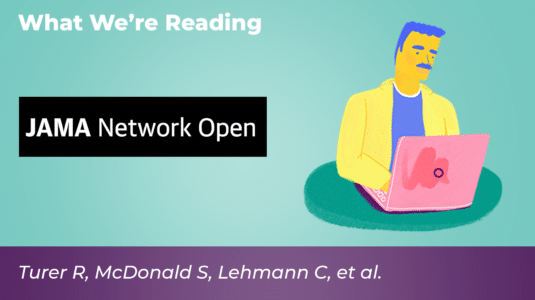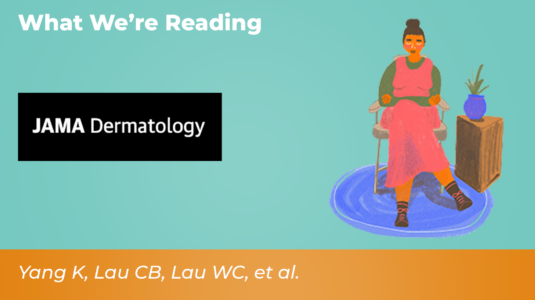This study examines care coordination breakdowns reported by patients living with dementia (PLWD) or their care partners. Interventions to improve communication across different care teams are needed to minimize the harmful effects of gaps in care coordination.
Other Specialties
Real-time electronic patient portal use among emergency department patients
These findings suggest that real-time patient portal use during ED encounters has increased over time, but disparities exist in portal access that mirror trends in portal usage more generally. Given emergency medicine’s role in caring for medically underserved patients, there are opportunities for EDs to enroll and train patients in using patient portals to promote engagement during and after their visits.
Patient perspectives on clinic note transparency within dermatology
Research evaluating patient experiences with accessing their dermatology clinic notes is currently limited. In this survey study, we aimed to assess dermatology patient experiences with viewing online medical records and sought to identify areas for improvement.
Risks and rewards of increasing patient access to medical records in clinical ophthalmology using OpenNotes
Clinicians in ophthalmology perceived both benefits and consequences of increasing patient access to ophthalmic records, and there were significant correlations between these perceptions and their conceptions of the clinician–patient relationship. This is the first study to assess potential ophthalmology provider attitudes toward sharing ophthalmic records. Although limited in sample size and power, this study demonstrates some ways patient-accessible ophthalmic records can affect the clinical practice of ophthalmology and emphasizes the unique challenges of OpenNotes in ophthalmology.
How do older patients with chronic conditions view reading open visit notes?
Authors examined the experiences with and perceptions of the effect of reading clinical outpatient visit notes on older adult patients with multiple chronic conditions at three healthcare organizations with significant experience sharing clinical notes with patients. The majority of respondents had read two or more clinical notes in the 12 months before the survey. Patients with more than two chronic conditions were more likely than those with fewer or none to report that reading their notes helped them remember their care plan, take their medications as prescribed, and understand and feel more in control of their medications. Very few patients reported feeling worried or confused about their health or medications due to reading their notes.
New federal rule requires open notes: what do clinicians and patients need to know? Insights and suggestions from a neuro-oncologist, a neurosurgeon, and a person living with a brain tumor
Starting April 5, 2021, a new US federal rule will be implemented as part of the 21st Century Cures Act that in part mandates patients will be able to access their test results, medication lists, referral information, and clinical notes rapidly and conveniently in electronic formats… “without delay.” As a result, it will be easier for patients to access the information in their records, including progress notes. … We know of no specific guidance nor formal study for neuro-oncologists and neurosurgeons on open notes, and there has been no formal study of brain tumor patients’ perceptions. Of 35 US institutions offering accredited neuro-oncology fellowships through the United Council of Neurologic Subspecialties, 26 report the capability of sharing notes with at least some patients, though the method of note sharing is unclear. For now, the authors offer suggestions for information that both neuro-oncology clinicians and patients want at their fingertips, as well as personal reflections on sharing and reading visit notes.
Open Anesthesia Records: Guidance for Anesthesia Providers on Implementing the Cures Act
Open anesthetic records may empower patients. Armed with previous anesthetic records, patients may be better prepared to communicate prior adverse events or side effects. We may also see more patients who seek the same “cocktail” of anesthetics that were provided to them in the past or may ask for the same anesthesia providers who have cared for them. Overall, patients should be able to better communicate their satisfaction or dissatisfaction with prior anesthetic experiences. Anesthesia providers will also have access to a wealth of important information, like airway management details, from prior out-of-network anesthetic records.
Open Notes in Oncology: Patient versus Oncology Clinician Views
Most oncology clinician views about open notes differ from those of patients. For example, 70% percent of clinicians agreed that open notes are a “good idea,” while 98% of patients endorsed this view. Further, 44% of oncology clinicians believed cancer patients would be confused by notes; just 4% of patients reported feeling confused after reading. Patient and clinician views about open notes in oncology are not aligned, with patients expressing considerably more enthusiasm.
Dermatopathologists’ Experience With and Perceptions of Patient Online Access to Pathologic Test Result Reports
In this survey study of 160 dermatopathologists, 57% reported that they have been contacted by patients about their pathologic test result reports.
An Opportunity to Engage Obstetrics and Gynecology Patients through Shared Visit Notes
Objective: To assess obstetrics and gynecology patients’ interest in reading their ambulatory visit notes, identification of documentation errors, and perceptions of sensitive language through a quality improvement (QI) initiative.
Methods: Beginning April 2016, as part of a QI project all obstetrics and gynecology patients (except family planning) were invited to read their ambulatory visit notes and provide feedback using a patient reporting tool codeveloped with patients. Two physicians with safety expertise reviewed all patient-reported errors over the first 16 months.





